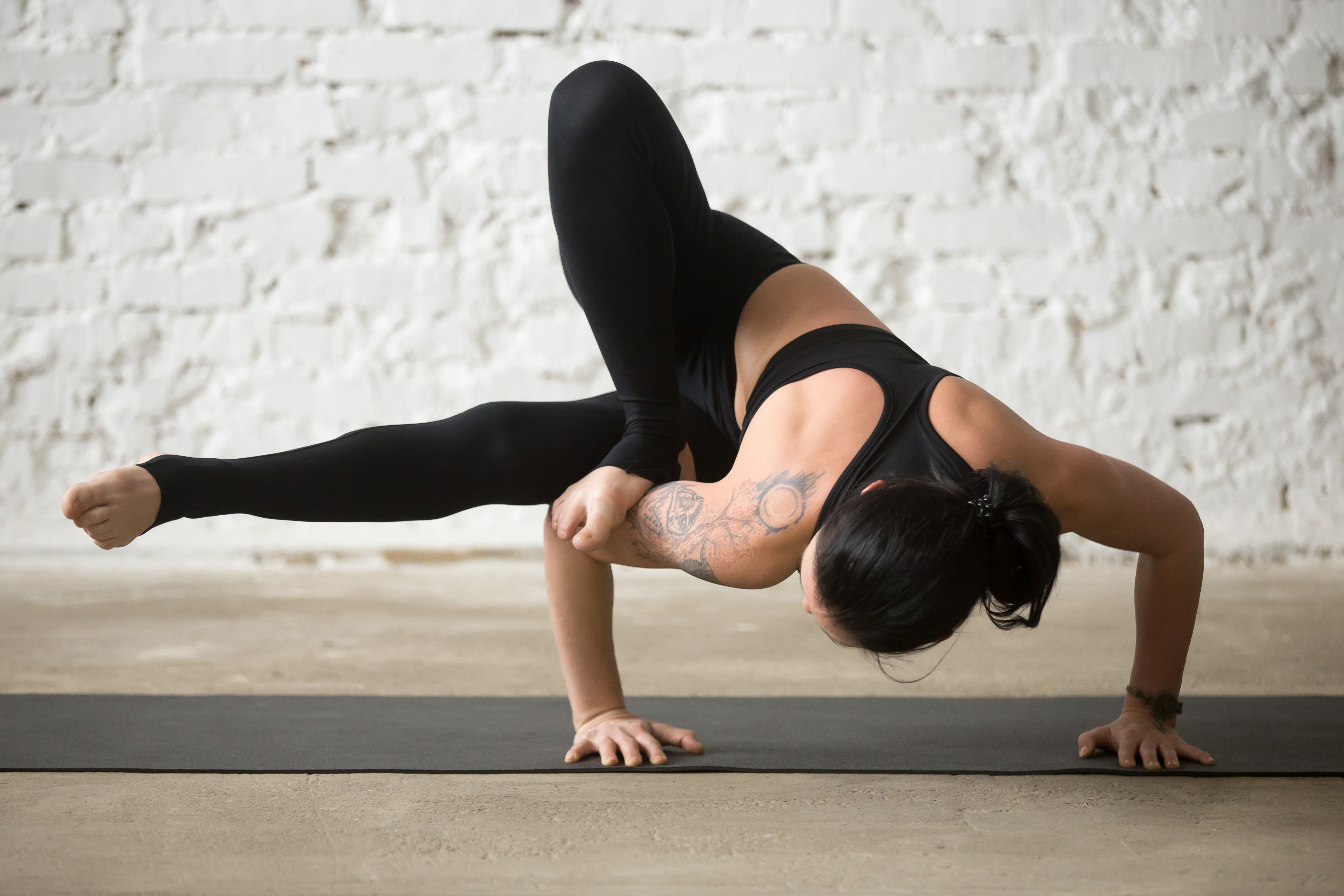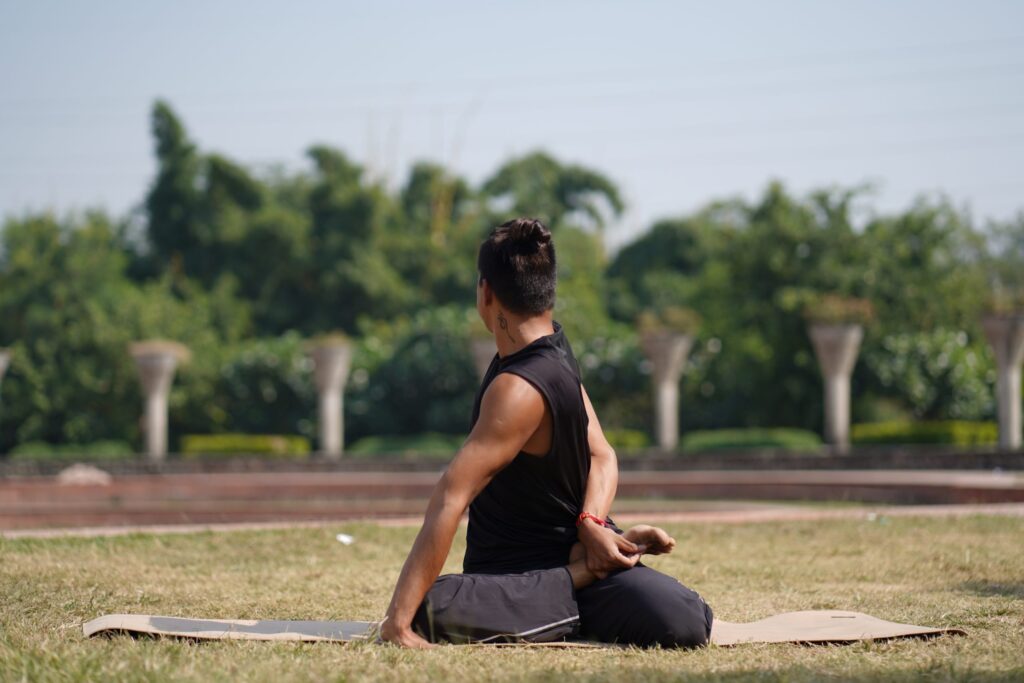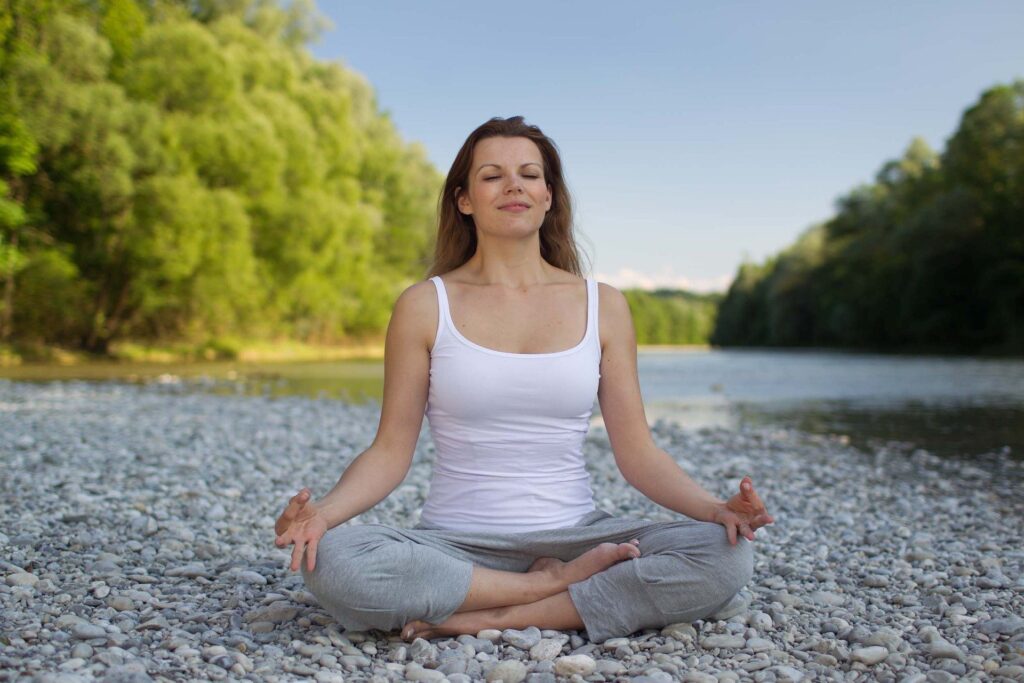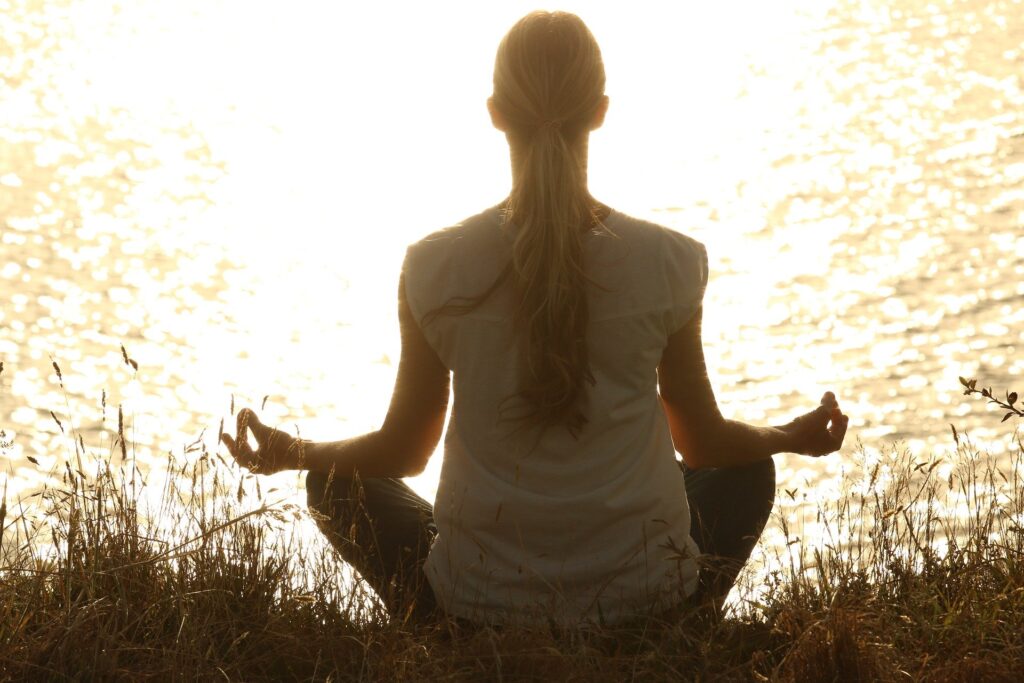Maksikanagasana ( मक्षिकानागासन ) or Parsva Bhuja Dandasana ( पार्श्व भुजा दंडासन ) is also known by different names – Dragonfly Pose, Hummingbird Pose and Grasshopper Pose. This advanced balancing pose strengthens wrists, forearms, elbows and shoulders. Read on to discover various such health benefits, steps and precautions of Maksikanagasana.
During the practice of Maksikanagasana, the body of a yogi resembles a resting Dragonfly/Grasshopper ( Maksika ). The regular practice of this asana invigorates peace of mind and promotes healthy mind-body coordination. Some ancient Indian yogic texts also call this posture as Parivrtta Eka Pada Danda Koundinyasana ( परिव्रत एक पद कौण्डिन्यासन ).
The Sanskrit word Parsva Bhuja Dandasana ( पार्श्व भुजा दंडासन ) is the combination of four words – ‘Parsva‘ ( पार्श्व ) meaning ‘Side’, ‘Bhuja‘ ( भुजा ) means ‘Arms’, ‘Danda‘ ( दण्ड ) means ‘Stick’ and ‘Asana‘ ( आसन ) meaning ‘Posture’. In this pose, a yogi needs to balance his body weight on both arms with a leg rests on the arm and other one extended like a stick.
How to practice the Dragonfly or Grasshopper Pose
Following are the step – by – step instructions to follow for the practice of Maksikanagasana ( Parsva Bhuja Dandasana )
Step 1 :
- Begin this pose with Parivrtta Ardha Utkatasana (Revolved Chair Pose) and cross your right ankle and place it over your left thigh.
Step 2 :
- Join your hands in Anjali Mudra & slightly twist your torso to the left bringing your right tricep into the inner sole of your right foot.
Step 3 :
- Maintaining the twist of your torso come down in the lower squat with your left foot and place palms on the floor on the left side.
Step 4 :
- Keep your hands shoulder wide apart & slowly transfer your body weight on arms by moving your shoulders in forward direction.
Step 5 :
- Now start pressing your right foot over your right elbow with firmness and then slowly raise your hips upward as high as possible.
Step 6 :
- At this moment lift your left foot up extending it to the right. Meanwhile engage your hips by pushing thighs against the hip joints.
Step 7 :
- Remain in this final position of the Grasshopper Pose for about 8 to 12 breaths or as long as you feel comfortable in maintaining it.
Step 8 :
- To release Maksikanagasana bring your right foot back to the floor and raise your palms to return into Parivrtta Ardha Utkatasana.
Step 9 :
- Relax for few moments and repeat all the above steps of the Grasshopper Pose on the other side as well for same length of time.
Modifications and Variations
Parsva Bakasana, Eka Pada Galavasana and Bala Parsva Bhuja Dandasana are major variations of Grassshopper or Dragonfly Pose.
To deepen experience of Maksikanagasana, just try out the following modifications and find the variations that works well for you :
1. If you’re unable to maintain balance in Maksikanagasana
- While maintaining body weight on arms with one leg, if you can’t hold the other leg straight, then you may rest that foot on blocks.
- You may place blocks under your palms and grip the fingers around the blocks, it would help you to maintain balance in this pose.
2. If your leg is slipping off the shoulder in Maksikanagasana
- You need to move the shoulders in the forward direction thus you can provide some gradient on your elbows to support the pose.
- While twisting torso in the position, place palms on the floor with firmness and a cushion under head to save from hitting the floor.
Precautions and Contraindications
Keep the following safety tips and information in mind when start practicing Maksikanagasana aka Dragonfly Pose or Grasshopper Pose
- It’s highly advisable that pregnant women should avoid practice of Dragonfly Pose as it may lead to unnecessary strain on abdomen.
- People with high blood pressure should avoid Dragonfly pose as this may put unwanted pressure on your heart that could be lethal.
- Avoid the Dragonfly Pose if you’ve any pain or injuries on the lower back, elbows, pelvis, knees, hips, shoulders, spine, wrists or neck.
- Patients with Carpal tunnel syndrome are strictly advised to avoid the practice of Dragonfly Pose as this can aggravate the condition.
- You must go slow during the Dragonfly Pose as instant shifting of bodyweight on the palms can result in some kind of elbow injuries.
Benefits of Maksikanagasana – The Dragonfly Pose
Following are top benefits of Maksikanagasana – The Dragonfly Pose that one can attain gradually with its regular practice :
Dragonfly Pose is an advanced arm balance pose improves your body’s strength, flexibility, endurance and sub–awareness.
1. Maksikanagasana helps to improve your digestive health
- During the practice of Dragonfly Pose your abdomen get squeezed that provides massaging effects on your entire digestive system.
- Furthermore, these twisting during Maksikanagasana tones core muscles, stimulates secretions and reduces pH of gastric contents.
Also Read :
2. Maksikanagasana helps to improve your overall flexibility
- The Dragonfly pose improves flexibility of your spine, legs, pelvis, thighs, groins, hamstrings, adductors and external rotators of hips.
- The practice of Maksikanagasana helps to lengthen and softens the vertebrae which corrects your body posture and its alignments.
Also Read :
3. Maksikanagasana helps to strengthens your Upper Body
- As you practice Dragonfly Pose the pressure in the form of body weight stimulates the musculoskeletal system of the upper body.
- Arm balancing pose of Maksikanagasana strengthens shoulders, wrists, palms, forearms, neck, chest, spine & lower back muscles.
Also Read :
4. Maksikanagasana aids to boost your focus and concentration
- Dragonfly Pose stimulates pituitary & hypothalamus glands that releases feel good neurotransmitters like endorphins & dopamine.
- The regular practice of Maksikanagasana improves the blood flow, soothes your nerves and aids in overcoming stress and anxiety.
Also Read :
5. Maksikanagasana improves the balance Mooladhara Chakra
- The twisting and mindful breathing during Dragonfly pose stimulates Muladhara Chakra that develops the sense of bodily balance.
- The activated Muladhara chakra due to daily practice of Maksikanagasana improves emotional stability, willpower and self-control.
Also Read :
Preparatory Poses
- Ardha Kapotasana
- Parivrtta Agnistambhasana
- Malasana
- Uttanasana
- Chaturanga Dandasana
- Utpluti Dandasana
- Bakasana
- Ardha Matsyendrasana
Follow Up Poses
- Balasana
- Utkatasana
- Adho Mukha Svanasana
- Ardha Chandrasana
- Adho Mukha Vrksasana
Tips for Beginners
- Maksikanagasana or Dragonfly pose is an advance level pose so always practice some warmup exercises before you do the pose.
- It is advised to consult a doctor if you’ve any medical problems & practice this pose under supervision of a certified yoga teacher.
- You may practice Maksikanagasana both in morning and evening with gap of 3–4 hours gap between your meal and the practice.
Conclusion
Maksikanagasana offers multiple health benefits – energize whole body, calms your mind, improves secretions of digestive juices, strengthens body muscles, boosts self-awareness, enhances blood circulation, stimulates Muladhara Chakra etc.
We really hope that this article would be useful guide for your practice of Maksikanagasana aka Dragonfly Pose. Try out this amazing asana after the long tiring day and do share your thoughts and suggestions on this article in the comment section below.
Also Read :
FAQs Related to Maksikanagasana & its Benefits
How do the practice of Maksikanagasana improve overall health ?
The Dragonfly Pose is a challenging arm balancing pose that involves deep twisting of torso, forward bending and hip opening. This wonderful posture helps to strengthens your abdominal organs, enhances flexibility in the hips and hamstrings. Moreover, it also helps to overcome anger, anxiety and laziness.




